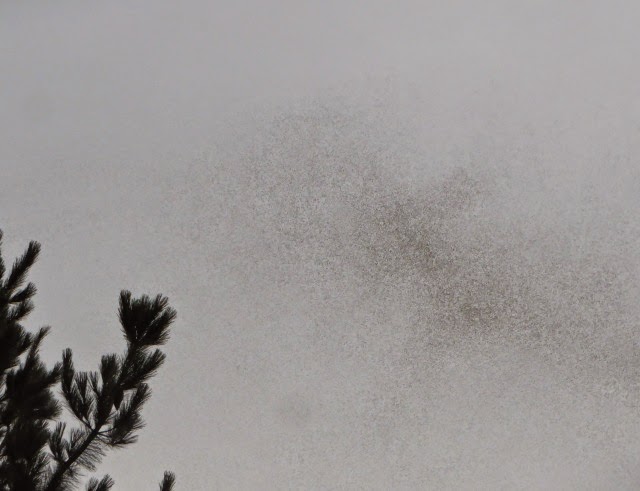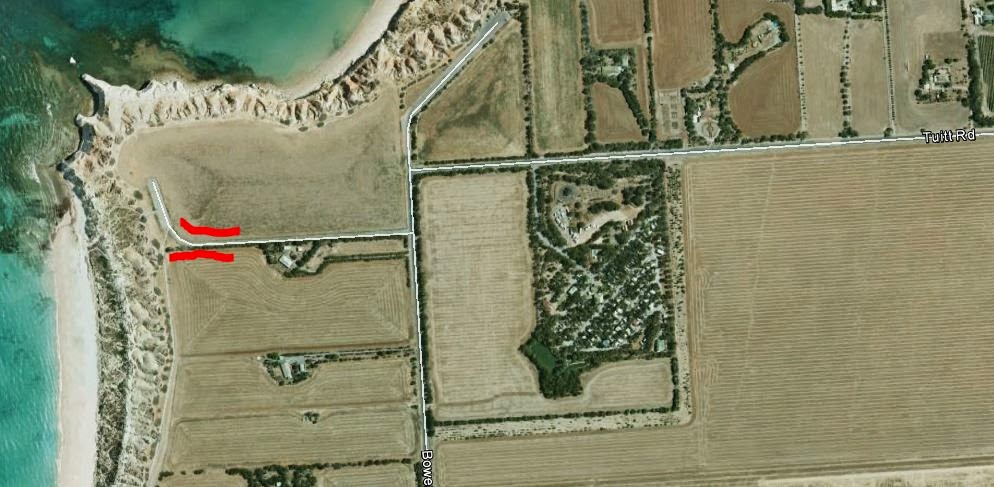Early thoughts on January weather
It has been hot and dry pretty much since Christmas. However, the morning of 10 January started out quite foggy out in Carwoola. This made the spider webs look very spiffy.
At the top of the hill in Widgiewa Rd it was very foggy but as we got down towards Captains Flat Rd the sky cleared and there was just a little cloud over the Taliesin Hills.
Back up at the high point there was now a view available to the East although the moisture was still going up.
All of this has caused me to look at some day x day weather information for January in previous years. Since 2013 most of this comes from my records but before that it's information collected by others for the Stoney Creek Gazette. Since I know some readers are not too fascinated by graphs and stats-babble here are the highlights:
On with the detail!
My first chart shows the number of days with a range of amounts of rain.
Clearly there are normally a lot of dry days in January.
The incidence of rain x day is largely a random event. The average rain per day of the month is 2mm with a range from 0.63 to 6.2mm. The high value is entirely due to a fall of 80mm in a day in one year. I thought it interesting to plot the average fall x day of the month across the years.
That is the blue line which bumps around near zero! I added +/- 1.96 Standard deviations to give a 95% confidence interval (CI). It is obviously logically impossible to get a negative amount of rainfall - and I hope no one is thinking about evaporation - but it does show that 0mm rainfall is well within the possible values on any day! Of course, with 75% of rainfall readings actually being 0mm the distribution of values is nothing like the normal distribution which is usually the basis for analysis of standard deviations.
Moving to temperatures here is a chart showing the % of days in each January with a maximum in the specified ranges.
There seem to have been several hot years during the drought in the early-mid noughties, with temperatures above 35oC.occurring on up to 40% of days. I'm glad we were overseas for most of that time - which probably explains why we don't remember it.
My next step was to compile a graph of average maximum temperatures and related statistics. In this case the standard deviations give a more logical result and don't include zero in the 95% confidence interval.
Note that in this case very few of the extremes are outside the CI. It would probably be reasonable to say temperatures outside a range from 20oC to 40oC would be quite unusual.
The process was repeated for Minimum temperatures, giving the following charts.
Although the mid-range only covers 5oC it contains the majority of days. It would seem fair to say that we can usually expect an overnight minimum between 10oC and 15oC which is quite comfortable.
The above finding is also reflected in the line chart. It also suggests that nearly all minima fall between 5oC and 20oC which pretty much covers the confidence interval.
This has taken quite a bit of work to create and I am not sure I want to do it every month. However I have now got some infrastructure in an ACCESS table and an EXCEL spreadsheet (with lotsa formulae) so I will use the broad idea for some analysis if it looks useful.
At the top of the hill in Widgiewa Rd it was very foggy but as we got down towards Captains Flat Rd the sky cleared and there was just a little cloud over the Taliesin Hills.
Back up at the high point there was now a view available to the East although the moisture was still going up.
All of this has caused me to look at some day x day weather information for January in previous years. Since 2013 most of this comes from my records but before that it's information collected by others for the Stoney Creek Gazette. Since I know some readers are not too fascinated by graphs and stats-babble here are the highlights:
- 75% of days in past Januarys past have had 0mm rainfall. More than 20mm in a day is unusual, but thunderstorms can dump a lot in a little while.
- Maximum temperatures over 30oC are normal and for several years comprised the majority of observations. The usual range of maxima seems to be between 20oC and 40oC.
- Minimum temperatures show a much tighter range with the majority falling between 10oC and 15oC . A minimum below 5oC or above 20oC would be very unusual.
On with the detail!
My first chart shows the number of days with a range of amounts of rain.
Clearly there are normally a lot of dry days in January.
The incidence of rain x day is largely a random event. The average rain per day of the month is 2mm with a range from 0.63 to 6.2mm. The high value is entirely due to a fall of 80mm in a day in one year. I thought it interesting to plot the average fall x day of the month across the years.
That is the blue line which bumps around near zero! I added +/- 1.96 Standard deviations to give a 95% confidence interval (CI). It is obviously logically impossible to get a negative amount of rainfall - and I hope no one is thinking about evaporation - but it does show that 0mm rainfall is well within the possible values on any day! Of course, with 75% of rainfall readings actually being 0mm the distribution of values is nothing like the normal distribution which is usually the basis for analysis of standard deviations.
Moving to temperatures here is a chart showing the % of days in each January with a maximum in the specified ranges.
There seem to have been several hot years during the drought in the early-mid noughties, with temperatures above 35oC.occurring on up to 40% of days. I'm glad we were overseas for most of that time - which probably explains why we don't remember it.
My next step was to compile a graph of average maximum temperatures and related statistics. In this case the standard deviations give a more logical result and don't include zero in the 95% confidence interval.
Note that in this case very few of the extremes are outside the CI. It would probably be reasonable to say temperatures outside a range from 20oC to 40oC would be quite unusual.
The process was repeated for Minimum temperatures, giving the following charts.
Although the mid-range only covers 5oC it contains the majority of days. It would seem fair to say that we can usually expect an overnight minimum between 10oC and 15oC which is quite comfortable.
The above finding is also reflected in the line chart. It also suggests that nearly all minima fall between 5oC and 20oC which pretty much covers the confidence interval.
This has taken quite a bit of work to create and I am not sure I want to do it every month. However I have now got some infrastructure in an ACCESS table and an EXCEL spreadsheet (with lotsa formulae) so I will use the broad idea for some analysis if it looks useful.













Comments